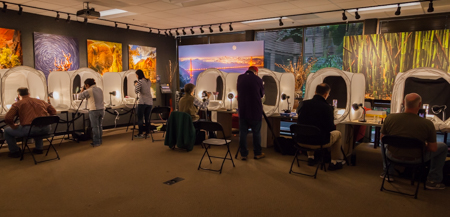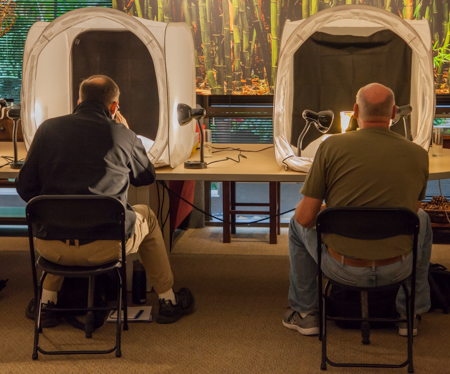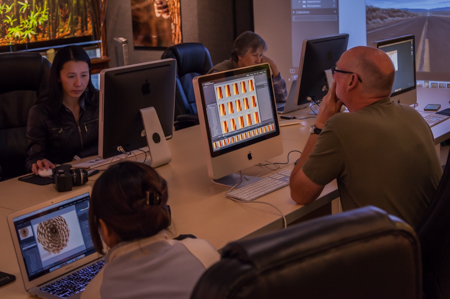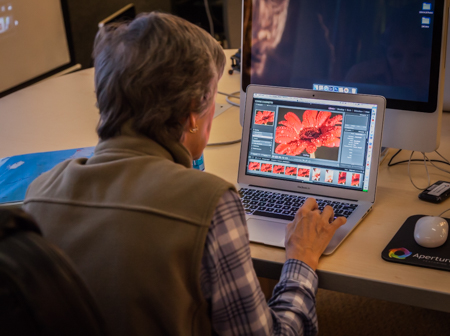
|
|
|||||
We've all seen them. Images online or in a magazine that show the intricate detail at the center of a flower, or the translucent wings of an insect, or vibrant color reflected in a single drop of water. They seem to transport us to another world. Welcome to the world of Macro Photography, a uniquely challenging and creatively expressive world that's really fun to visit.
Recently, I met with seven excited students at our Aperture Academy studio in San Jose, California, on a rainy Sunday morning, to spend the day exploring this strange new world and enhance our skills as photographers.
When everyone had gotten settled, I introduced myself and shared some of what our class would cover, and then I turned it over to the students so I could find out a little more about them, what kind of gear they had, and what brought them to our workshop. Happily, I discovered that all my students were properly equipped and I knew this was going to be a great day!
After the introductions were complete, it was time for a brief presentation to introduce Macro Photography. I defined macro vs. "close-up" photography, introduced some of the types of equipment that is available, and talked about what characteristics make a macro lens unique. Then, I moved on to the more technical aspects involving the exposure triangle: aperture, ISO, and shutter speed. I spent a significant portion of time reviewing how depth of field impacts macro photography, which is important to understand because minor adjustments can make a big impact on the finished image. Finally, I reviewed some of the creative aspects of composition, reminding students that the use of leading lines and rule of thirds principles are just as important in macro photography as in any other genre.
 With the basics covered, it was time to let the fun begin and start shooting. Each student had their own individual light station, and set up their tripods and cameras. I described the three main subjects we would be working with, and helped everyone get set up for the first round. Over the next two hours, I worked with each of my students to set up shots and explore different angles and subject matter to get the images they wanted. My goal was to push limits and try to showcase common objects in a new way, and help students find subjects that they connected with to create stunning images.
With the basics covered, it was time to let the fun begin and start shooting. Each student had their own individual light station, and set up their tripods and cameras. I described the three main subjects we would be working with, and helped everyone get set up for the first round. Over the next two hours, I worked with each of my students to set up shots and explore different angles and subject matter to get the images they wanted. My goal was to push limits and try to showcase common objects in a new way, and help students find subjects that they connected with to create stunning images.
A very useful technique for macro photographers to learn is that of focus-stacking. We often find ourselves in situations that require us to shoot in shallow depths of field, either due to lack of light, or because we want a certain softness or tone to our images. Under those conditions, it can be difficult to get an image that is crisp and sharp all the way through; we end up with images that are sharp in some areas, but not others. This challenge can be overcome by focus-stacking images. This technique involves taking a series of several images, each one with a different plane of the image in focus, so that when "stacked" in Photoshop, you get one image that is sharp all the way through. I worked with each student to get their series of images that we could "stack" later during processing.
 After I had covered each of the planned subjects I wanted the students to try, we still had a little time before lunch break, so I told everyone they could pick their own subject and let their creativity loose! It was really fun to see what everyone picked and connected to. Some went back to the flowers to try other angles, other students picked peacock feathers, or pine cones, or purple cabbage! I could see that my students were really understanding the concepts we had covered, and they were creating some really beautiful images.
After I had covered each of the planned subjects I wanted the students to try, we still had a little time before lunch break, so I told everyone they could pick their own subject and let their creativity loose! It was really fun to see what everyone picked and connected to. Some went back to the flowers to try other angles, other students picked peacock feathers, or pine cones, or purple cabbage! I could see that my students were really understanding the concepts we had covered, and they were creating some really beautiful images.
Soon, it was time to break for lunch and magically transform our studio stations into our classroom for processing the morning's images. (Well, not really magically, but with assistance from some very helpful students.)
After lunch, everyone settled around the table and quickly got to importing their images into Lightroom, so that we could see the results of the morning's efforts.
I showed everyone my basic workflow in Lightroom, starting with how to review and select favorite images in the Library module. Then, I moved to the Develop module, covering how to crop an image, adjust exposure, contrast, and white balance. Next, I showed how to sharpen an image and add some slight vignetting, just to emphasize the focal point of my image. Finally, I showed everyone how to export their finished images, using settings designed for either web posting or printing.
But, wait! There's more! We still hadn't done anything with the images we prepared for stacking....
For our big finale, I showed my students how to select those images and open them in Photoshop layers to align and blend for a final image that was sharp and crisp, edge to edge. The final results were really wonderful to see! This is a technique that takes some practice, but now my students have one more tool in their photographic tool bags.
We spent a bit more time addressing specific questions, and then set up for our group shot to document the fun we had. After one final thank you to my students for letting me share their day, I bid them all adieu, and wished them well with their new-found macro photography skill.
Until next time,
DeAnna, and the rest of the Aperture Academy team!
P.S. If you'd like to join us at one of our workshops, you can find the schedule/sign up here.
 |
 |
 |
 |
 |
 |
 |
 |
 |
 |
 |
 |
 |
 |
|
 |
Other Cool Stuff→ Past Workshop Photos → 72dpi.com → How-To Articles → Photographer of the Month |
 |
Contact Us→ Contact Us → About Us → Site Map |
© 2009-2024 Aperture Academy, Inc.






